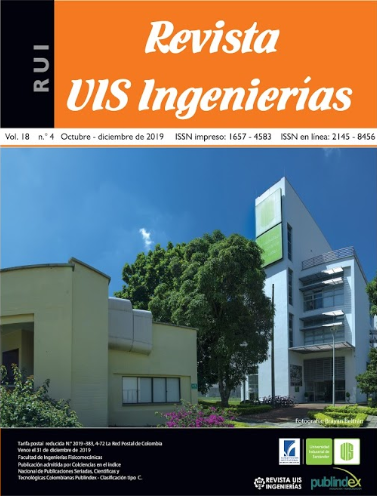Asphaltenes precipitation as a mechanism to obtain a hydrophobic surface in aluminum
Published 2019-07-22
Keywords
- aluminum foam,
- asphaltenes,
- surface free energy,
- polarity,
- contact angle
How to Cite
Copyright (c) 2019 Revista UIS Ingenierías

This work is licensed under a Creative Commons Attribution-NoDerivatives 4.0 International License.
Abstract
This study was focused on the development of a surface alteration protocol for aluminum discs based on the asphaltenes precipitation, to the future development of cellular aluminum treated superficially for the treatment of contaminated water with oil. Roughness tests were developed to guarantee homogeneity of the samples considered. Water and oil contact angles were measured before and after treatment to evaluate variations in the surface affinity of the specimens and it was found that, although there are variations consistent with the increase of the surface hydrophobicity, this is not significant inside the design of experiments proposed within the methodology.
Downloads
References
[2] IPIECA, Energy API, and International Association of Oil & Gas Producers, “Guidelines on implementing spill impact mitigation assessment (SIMA),” 2017.
[3] ITOPF, “Uso de skimmers en la respuesta a la contaminanción por hidrocarburos,” Doc. Inf. técnica, vol. 5, pp. 1–16, 2011.
[4] S. Yavari, A. Malakahmad, and N. B. Sapari, “A Review on Phytoremediation of Crude Oil Spills,” Water, Air, Soil Pollut., vol. 226, no. 8, p. 279, 2015, doi: 10.1007/s11270-015-2550-z.
[5] V. Broje and A. A. Keller, “Optimization of Oleophilic Skimmer Recovery Surface: Field Testing at Ohmsett Facility. Final Report Acknowledgements,” Santa Barbara, 2006.
[6] M. Barrientos and C. Soria, “Indice de precios de metales - Precio Mensual - Índice,” Index Mundi, 2019. [Online]. Available: http://www.indexmundi.com/es/ precios-de-mercado/?mercancia=indice-de-precios-de-metales. [Accessed: 11-Julio-2019].
[7] A. Calle Fernández, “Estudio de Comportamiento Mecánico de las Espumas Pulvimetalurgicas de Aluminio,” Escuela Técnica Superior de Ingenieros de Minas, 2012.
[8] T. Rezayi, M. H. Entezari, and F. Moosavi, “The variation of surface free energy of Al during superhydrophobicity processing,” Chem. Eng. J., vol. 322, pp. 181–187, 2017, doi: 10.1016/j.cej.2017.04.023.
[9] N. J. Shirtcliffe, G. McHale, S. Atherton, and M. I. Newton, “An introduction to superhydrophobicity,” Adv. Colloid Interface Sci., vol. 161, no. 1, pp. 124–138, 2010, doi: 10.1016/j.cis.2009.11.001.
[10] K. Akbarzadeh Ahmed Hammami Abdel Kharrat Dan Zhang Edmonton et al., “Los asfaltenos: Problemáticos pero ricos en potencial,” 2007.
[11] M. D. Lobato, F. Gámez, S. Lago, and J. M. Pedrosa, “The influence of the polarity of fractionated asphaltenes on their Langmuir-film properties,” Fuel, vol. 200, pp. 162–170, 2017, doi: 10.1016/j.fuel.2017.03.059.
[12] B. Bienfait and P. Ertl, “JSME: a free molecule editor in JavaScript,” J. Cheminform., vol. 5, no. 1, p. 24, 2013, doi:10.1186/1758-2946-5-24.
[13] C. A. Franco, N. N. Nassar, and F. B. Cortés, “Removal of oil from oil-in-saltwater emulsions by adsorption onto nano-alumina functionalized with petroleum vacuum residue,” J. Colloid Interface Sci., vol. 433, pp. 58–67, 2014, doi: 10.1016/j.jcis.2014.07.011.
[14] C. A. Franco, F. B. Cortés, and N. N. Nassar, “Adsorptive removal of oil spill from oil-in-fresh water emulsions by hydrophobic alumina nanoparticles functionalized with petroleum vacuum residue,” J. Colloid Interface Sci., vol. 425, pp. 168–177, 2014, doi: 10.1016/j.jcis.2014.03.051.
[15] M. Moro Piñeiro, Metrología: introducción, conceptos e instrumentos. Universidad de Oviedo, 2012.
[16] ISO, “Softgauge Basic Framework ISO 4287-1997,” 1997.
[17] J. G. Delgado, “Cuaderno FIRP S369-A Asfaltenos composición, agregación, precipitación,” Mérida, 2006.

